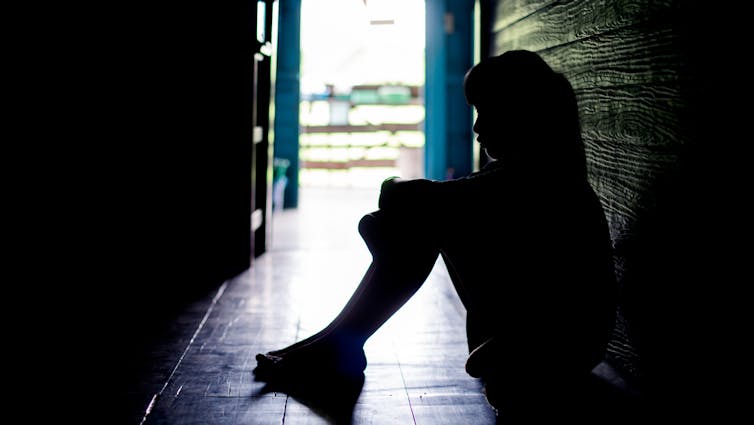Source: The Conversation (Au and NZ) – By Silke Meyer, Professor of Social Work; Leneen Forde Chair in Child & Family Research, Griffith University

Photo by Ron Lach/Pexels, CC BY
Federal, state and territory governments this week released Australia’s ten-year National Plan to end Violence against Women and Children 2022-2032, which is framed by the ambitious goal of ending gender-based violence in one generation.
The plan organises governments’ commitments across four domains: prevention, early intervention, response, and recovery and healing.
But there’s a crucial part of the story you might have missed: how and why the plan acknowledges children and young people as victim-survivors in their own right, and what needs to happen next.

Shutterstock
Read more:
Almost 9 in 10 young Australians who use family violence experienced child abuse: new research
Children and young people’s experiences of family violence
Latest Australian data on domestic and family violence show that:
-
one in two young people who experience domestic and family violence during childhood go on to use violence in the home during adolescence
-
of those who report using violence in the home during adolescence, almost nine in ten report childhood experiences of domestic and family violence and other forms of maltreatment.
This highlights the intergenerational transmission of domestic and family violence.
Ending gender-based violence, including domestic and family violence, requires a clear commitment to ending children’s and young people’s experiences of such violence.
It also requires a clear commitment to providing age-appropriate recovery support and services for children experiencing domestic and family violence.
Childhood experiences of domestic and family violence further increase young people’s risk of:
-
poor mental health
-
suicide
-
educational disengagement
-
disability and other chronic health problems.
Many of these are associated with an increased risk of being a victim or perpetrator of domestic and family violence.
We need not just an acknowledgement of children as victim-survivors in their own right, but also a commitment to boost resourcing of child-centred recovery support.
Every child experiencing violence must have access to recovery support.
The status quo: children as an extension of their parent
For too long, system responses to domestic and family violence in Australia have seen children only as extensions of their primary carer. This means we fail to recognise and adequately respond to children’s unique safety, support and recovery needs.
This can make children invisible in relevant risk assessment; assessors may miss the specific risk to children’s safety and wellbeing in the context of domestic and family violence. This can lead to preventable harm, injury or even homicide and suicide.
Approximately one child a fortnight is killed in the context of domestic and family violence in Australia.
More data are needed on the link between domestic and family violence and young people’s suicide. But existing research has identified a link between childhood experiences of domestic and family violence, the impact of unaddressed trauma and an increased risk of suicide.
So embedding short- and long-term recovery support for children affected by domestic and family violence is not only an investment in ending domestic and family violence in one generation. It is also an investment in securing children’s lives.
But it requires long-term government funding and political will.

Shutterstock
Building whole-of-system responses for children and young people
Acknowledging children and young people as victim-survivors in their own right is a starting point.
Their specific support needs and how these will be met must be clearly embedded in the first five-year action plan, to be delivered in early 2023.
The rights and needs of children and young people must be considered at each point of the plan – from prevention to early intervention, through to response and recovery.
This includes early childhood- and school-based education targeted at gender equality and respectful relationships.
Responses must recognise the intersecting support needs of young people at risk of using violence in the home.
This includes recognising many young people using violence in the home have childhood trauma themselves.
Recognising this would help build trauma informed responses across education, child and family welfare services, child and young mental health services and youth justice.
Housing needs for children and young people fleeing family violence
The upcoming action plan must address the paucity of crisis housing options for children and young people experiencing domestic and family violence.
Australia currently has minimal domestic and family violence specialist crisis intervention and accommodation services for young people as victim-survivors in their own right.
The current service system is geared towards adult victim-survivors. If a child flees violence without their parent, they are met with a service system that does not cater to them. As a result they face significant risk of homelessness.
The national plan provides an opportunity to address this critical service system gap but young people must be able to access a domestic and family violence informed response, whether they’re with or without a victim-parent. They need protection, housing and recovery support.
Taking children’s risk and safety seriously
In developing the first action plan, governments must consult closely with experts, including practitioners, academics and – most importantly – young advocates who have experienced domestic and family violence.
Interventions for and responses to children and young people experiencing domestic and family violence must be informed by lived experience.
Getting this right won’t be easy and it won’t be cheap. But properly meeting the needs of children and young people experiencing domestic and family violence will help secure a safer future for the next generation.
![]()
Silke Meyer receives funding from Australia’s National Research Organisation for Women’s Safety, the Australian Institute of Criminology, and the Qld Department for Children, Youth Justice and Multicultural Affairs. In 2021 Silke co-led the National Plan Stakeholder and Victim-Survivor Advocates Consultation Projects.
She is a Subject Matter Expert for the clinical management committee of 1800RESPECT.
Kate receives funding for family violence related research from the Australian Research Council, Australian Institute of Criminology, Australia’s National Research Organisation for Women’s Safety, the Victorian Government and the Department of Social Services. In 2021 Kate led the National Plan Stakeholder and Victim-Survivor Advocates Consultation Projects. This piece is written by Kate Fitz-Gibbon in her capacity as Director of the Monash Gender and Family Violence Prevention Centre and are wholly independent of Kate Fitz-Gibbon’s role as Chair of Respect Victoria.
– ref. To end gender-based violence in one generation, we must fix how the system responds to children and young people – https://theconversation.com/to-end-gender-based-violence-in-one-generation-we-must-fix-how-the-system-responds-to-children-and-young-people-192839








